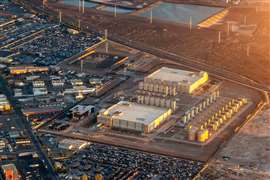Another Katrina victim brought low
10 April 2008
Established in 1851, the Armed Forces Retirement Home in Gulfport, Mississippi, was home to more than 400 veterans prior to the arrival of Hurricane Katrina in August 2005. The residents were evacuated and rehoused elsewhere after the home was forced to close as a result of the damage it sustained during the storm.
CST Environmental was brought in to clear the site, working in conjunction with explosives specialist Dykon Enterprises.
The four phase project began in july 2007, when CST began asbestos abatement. It took the company four weeks to remove over 150,000 ft2 (13,936 m2) of asbestos containing material.
CST then moved on to the second stage, which consisted of the soft strip of the ground floor of the building and the demolition of approximately 75,000 ft2 (6,968 m2) of structures surrounding the tower. To clear the ground floor, CST removed all interior walls, ceilings and doors to leave nothing but the structure of the building. Blowing out the ground floor was crucial in getting the building to collapse – charges placed on the upper floors helped to control the direction of fall and to break up the 350,000 ft2 (32,516 m2) structure to aide in the removal of the resulting debris. During this phase, CST also removed as much of the ferrous metal in the building as possible, all of which was recycled.
Next came the preparation work for the placement of the explosive charges – 300 lb (137 kg) of which were required for this job. Holes were drilled using heavy equipment through the solid concrete columns. According to Dykon president Jlm Redyke: “Placement of the holes were critical, as the charges must be precisely placed to achieve a successful implosion.”
CST also prepared the interior beams for linear copper clad shaped charges (LSCs), with Dykon precisely placing each charge (an LSC is a continuous explosive core in a seamless metal sheath that produces a linear cutting action when detonated). Each charge was wrapped in a reinforced box with layers of reinforced chain and a heavy geotechnical fabric, with the fabric minimising the risk of nearby charges being damaged by flying debris. The chain reinforcement was required to direct the energy from the charge to cut the steel beams in the structure. Conventional explosives were also placed vertically on the building's columns to shift them out of position. The explosives used in the building were set to be detonated by time delays to minimise the shock wave.
Rapid fall
All told, the precise placement of the mix of shaped and conventional charges caused the building to come down in less than 11 seconds.
According to Dykon's Mr Redyke: “The most challenging aspect of this project were the elevator shafts and stair towers. They were poured-in-place concrete and very unique for this type of structure. Typically, the elevator shafts and stair towers are on a steel frame. We took extra measures to ensure this implosion was a success.”
The final phase of the project is now underway, namely the clearance of the implosion debris and final site grading. CST is separating the remaining scrap metal and construction debris, and processing the remaining concrete for offsite recycling. CST is hopeful that it will be able to recycle about 70% of all debris from the job, well ahead of average recycling rates. Once the building slab is removed. CST will also grade the site.
At the height of the demolition work, CST had a total offive excavators, a tracked loader, three skid steers, two 25 ft (7.7 m) aerial work platforms and a crew of 60 labourers on the AFRH site.




